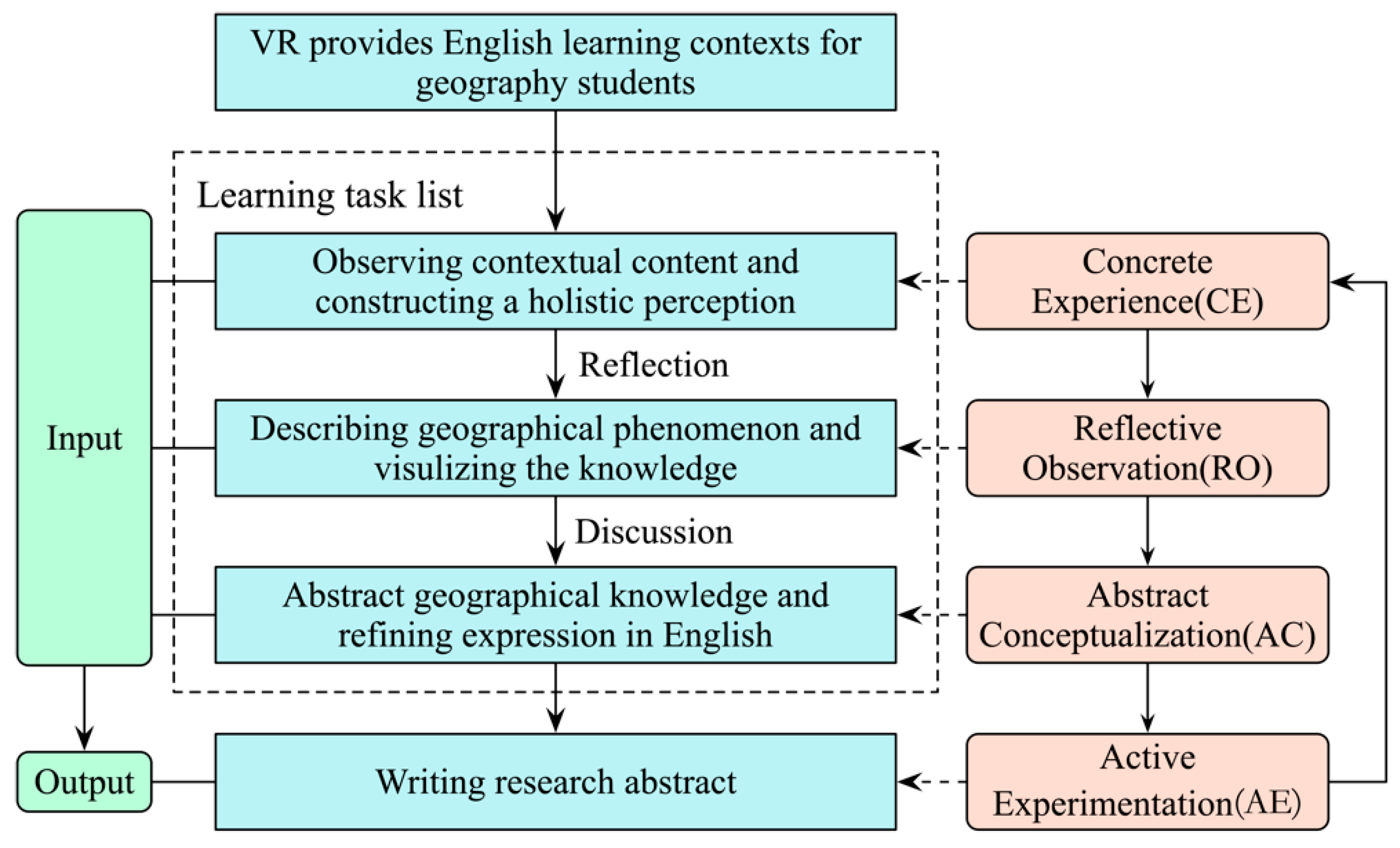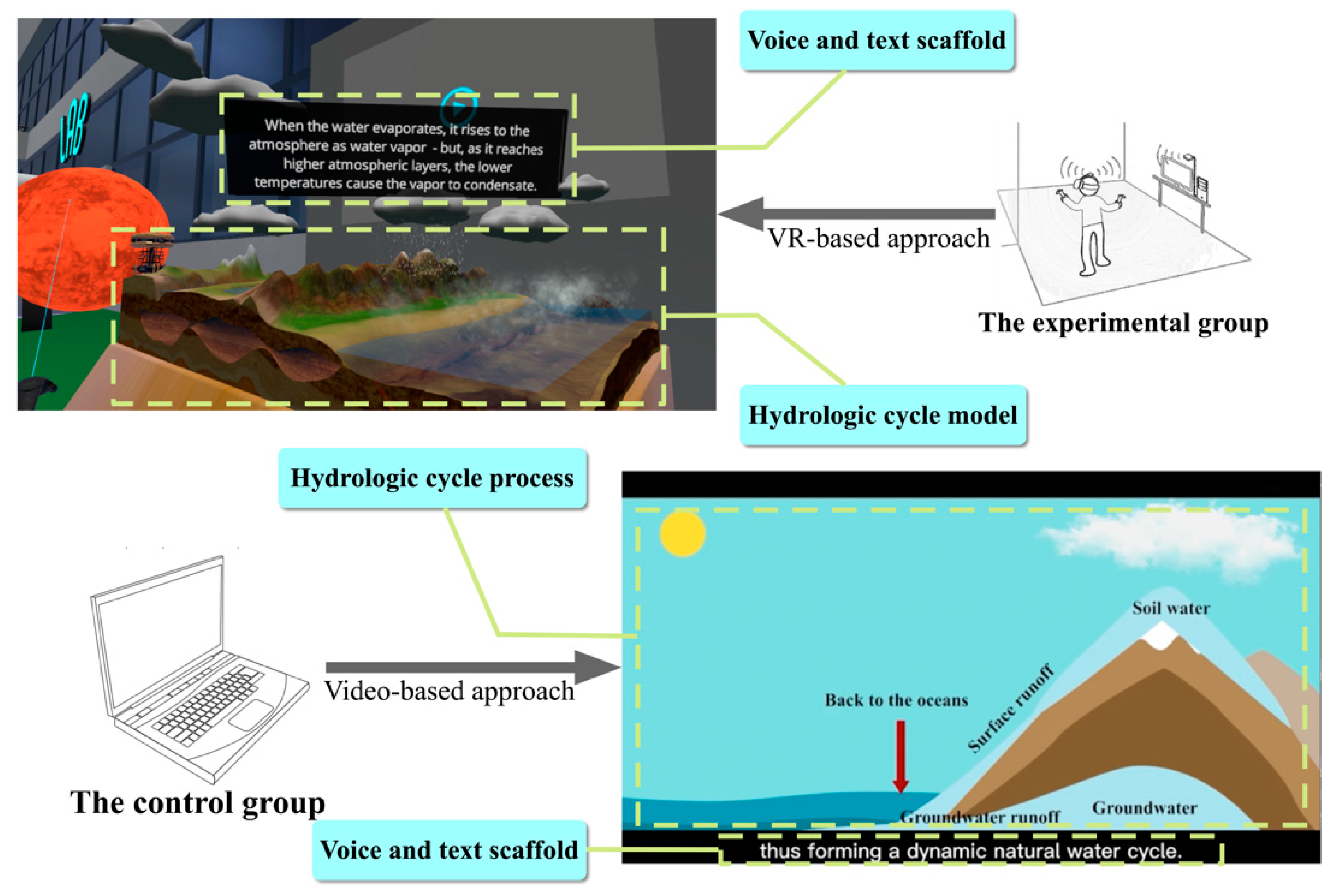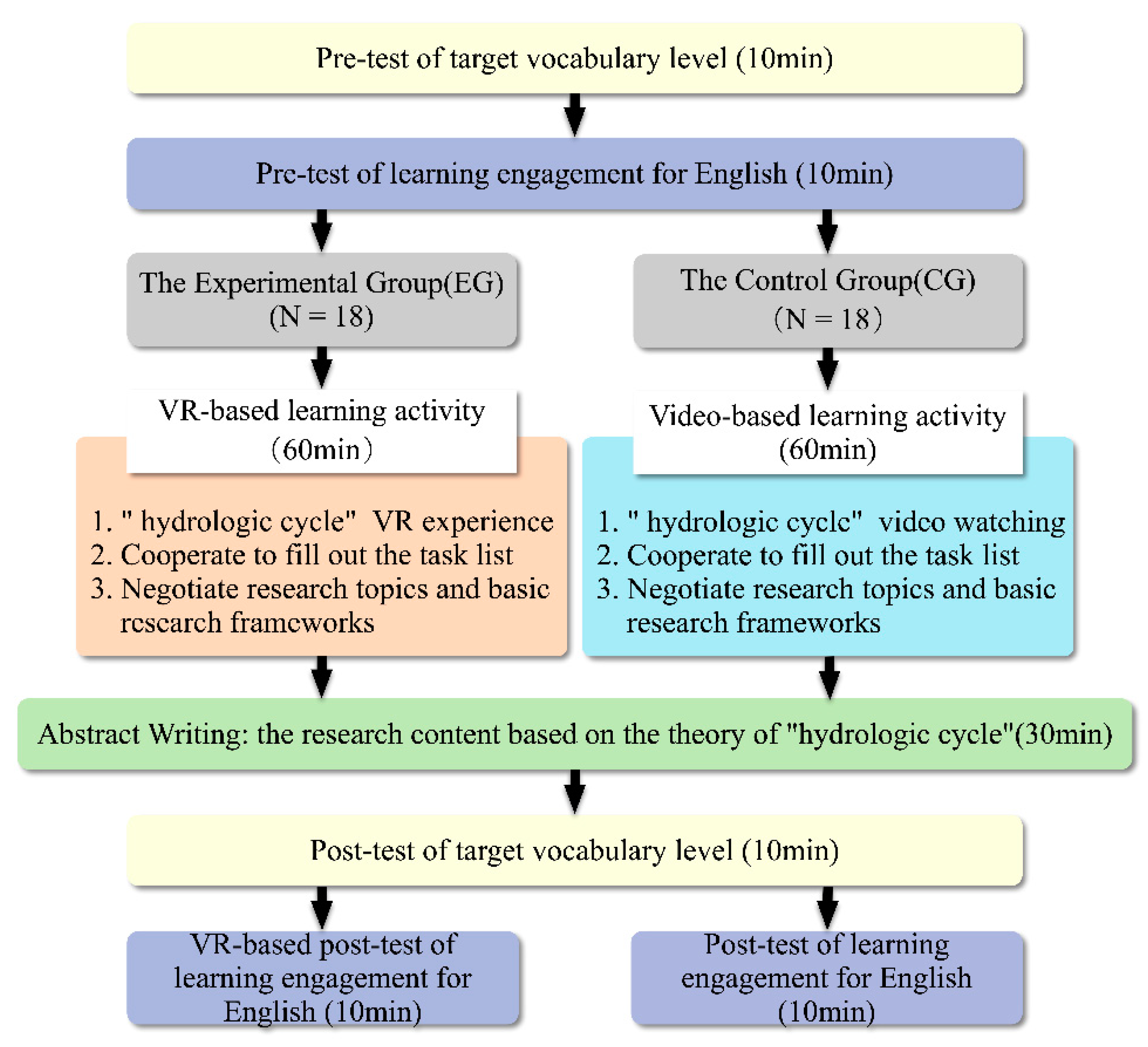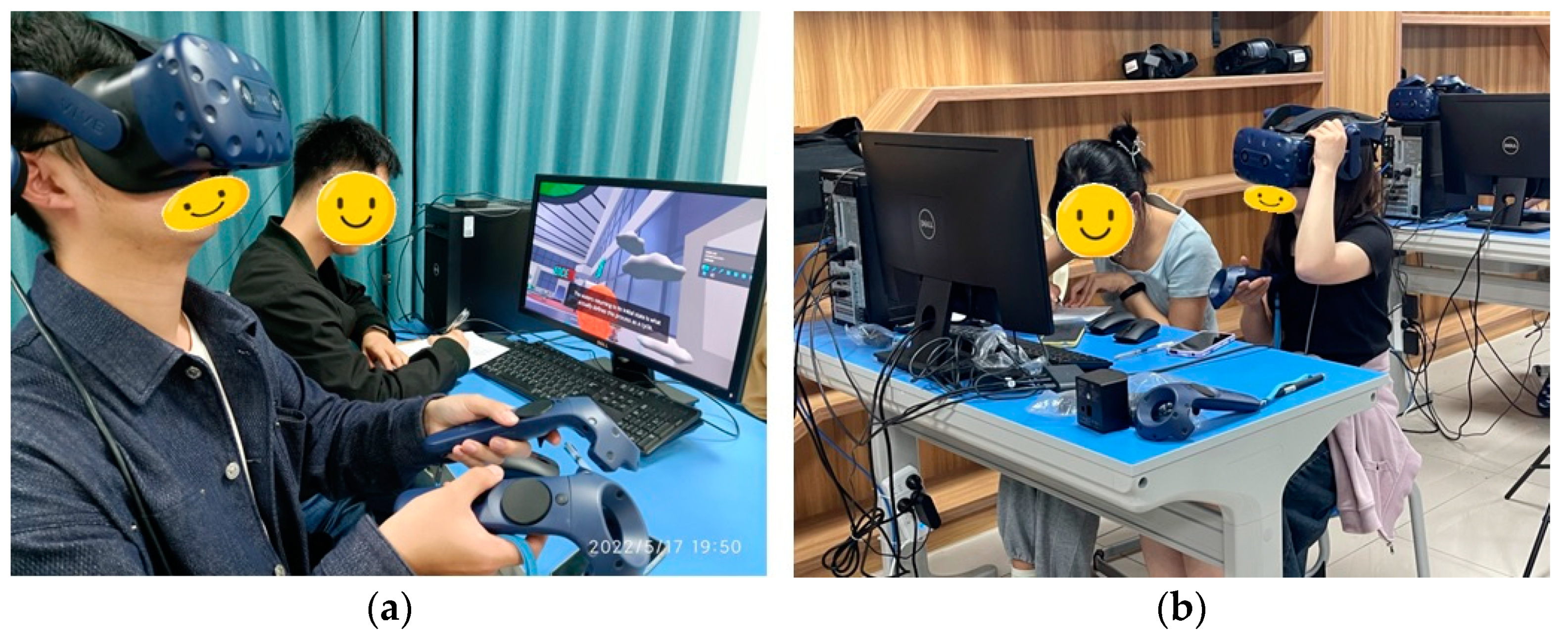An Experiential Learning-Based Virtual Reality Approach to Foster Students’ Vocabulary Acquisition and Learning Engagement in English for Geography
Abstract
1. Introduction
- Does an experiential learning-based VR approach help geography students understand abstract concepts in geography? Does this approach help in acquiring vocabulary?
- Does an experiential learning-based VR approach have a positive impact on students’ learning engagement?
2. Literature Review
2.1. Experiential Learning
2.2. Virtual Reality-Based English Learning
3. Methods
3.1. A VR-Based English Vocabulary Acquisition Approach for Geography Students
3.2. Experiment Design
3.2.1. Participants
3.2.2. Procedure
3.3. Measuring Tools
3.3.1. Questionnaire of Learning Engagement
3.3.2. Target Vocabulary Test
3.3.3. Abstract Writing Test
4. Experimental Results
4.1. Analysis of Target Vocabulary Test Results
4.2. Analysis of the Level of Learning Engagement
4.3. Comparative Analysis of All Dimensions of Abstract Writing
5. Discussions
5.1. The Potential of the Experiential Learning-Based VR Approach for Incidental Vocabulary Acquisition
5.2. The Potential of the Experiential Learning-Based VR Approach for Learning Engagements
6. Conclusions
Author Contributions
Funding
Institutional Review Board Statement
Informed Consent Statement
Data Availability Statement
Conflicts of Interest
References
- Chen, C.H.; Hung, H.T.; Yeh, H.C. Virtual reality in problem-based learning contexts: Effects on the problem-solving performance, vocabulary acquisition and motivation of English language learners. J. Comput. Assist. Learn. 2021, 37, 851–860. [Google Scholar] [CrossRef]
- Schmitt, N. Researching Vocabulary; Palgrave MacMillan: Nottingham, UK, 2010. [Google Scholar]
- Webb, S. Extensive viewing: Language learning through watching television. In Language Learning beyond the Classroom; Routledge: London, UK, 2015; pp. 159–168. [Google Scholar]
- Peters, E. The effect of imagery and on-screen text on foreign language vocabulary learning from audiovisual input. TESOL Q. 2019, 53, 1008–1032. [Google Scholar] [CrossRef]
- Li, J. The Role of Massively Multiplayer Role-Playing Games in Facilitating Vocabulary Acquisition for English Language Learners: A Mixed-Methods Study. Ph.D. Thesis, Clemson University, Clemson, SC, USA, 2019. [Google Scholar]
- Liu, P.L. Mobile English vocabulary learning based on concept-mapping strategy. Lang. Learn. Technol. 2016, 20, 128–141. [Google Scholar]
- Rupley, W.H.; Slough, S. Building prior knowledge and vocabulary in science in the intermediate grades: Creating hooks for learning. Lit. Res. Instr. 2010, 49, 99–112. [Google Scholar] [CrossRef]
- Webb, S. (Ed.) The Routledge Handbook of Vocabulary Studies; Routledge: London, UK, 2019. [Google Scholar]
- Blyth, C. Immersive technologies and language learning. Foreign Lang. Ann. 2018, 51, 225–232. [Google Scholar] [CrossRef]
- Radianti, J.; Majchrzak, T.A.; Fromm, J.; Wohlgenannt, I. A systematic review of immersive virtual reality applications for higher education: Design elements, lessons learned, and research agenda. Comput. Educ. 2020, 147, 103778. [Google Scholar] [CrossRef]
- Wilang, J.D.; Soermphongsuwat, A. Virtual reality for undergraduate English language learners: A formative study. In Proceedings of the 49th International Simulation and Gaming Association, Nakorn Pathom, Thailand, 9–13 July 2018. [Google Scholar]
- Urun, M.F.; Aksoy, H.; Comez, R. Supporting foreign language vocabulary learning through Kinect-based gaming. Int. J. Game-Based Learn. 2017, 7, 20–35. [Google Scholar] [CrossRef]
- Shih, Y.C. Vocabulary acquisition from a virtual street-view context. Int. J. Comput. Assist. Lang. Learn. Teach. 2020, 10, 14–32. [Google Scholar] [CrossRef]
- Hughes, J.N.; Luo, W.; Kwok, O.M.; Loyd, L.K. Teacher-student support, effortful engagement, and achievement: A three-year longitudinal study. J. Educ. Psychol. 2008, 100, 1–14. [Google Scholar] [CrossRef]
- Gardiner, P. Playwriting and flow: The interconnection between creativity, engagement and skill development. Int. J. Educ. Arts 2017, 18, 1–25. [Google Scholar]
- Stroud, R. Student engagement in learning vocabulary with CALL. In Proceedings of the European Association for Computer Assisted Language Learning, Groningen, The Netherlands, 20–23 August 2014. [Google Scholar]
- Ding, Y. Effectiveness evaluation model of students’ English listening ability based on immersive computing. Mob. Inf. Syst. 2022, 2022, 9. [Google Scholar] [CrossRef]
- Hagge, P. Student perceptions of semester-long in-class virtual reality: Effectively using “Google Earth VR” in a higher education classroom. J. Geogr. High. Educ. 2021, 45, 342–360. [Google Scholar] [CrossRef]
- Alexe, M. Developing Professional English Vocabulary through Computer Based Simulted Situations. Elearning Softw. Educ. 2013, 3, 249–254. [Google Scholar] [CrossRef]
- Dashkina, A.I.; Khalyapina, L.P.; Kobicheva, A.M.; Odinokaya, M.A.; Tarkhov, D.A. Developing a model of increasing the learners’ bilingual professional capacity in the virtual laboratory environment. Appl. Sci. 2020, 10, 7022. [Google Scholar] [CrossRef]
- Kent, M.; Gilbertson, D.D.; Hunt, C.O. Fieldwork in geography teaching: A critical review of the literature and approaches. J. Geogr. High. Educ. 1997, 21, 313–332. [Google Scholar] [CrossRef]
- Moore, N. Learning by doing: Introducing research skills to geography undergraduates. In Proceedings of the 3rd Annual Conference of the National Academy for the Integration of Research, Teaching and Learning, Dublin, Ireland, 11–12 November 2009. [Google Scholar]
- Moorman, L.; Cerney, D.; Gielstra, D.; Foster, E.; Villa Cerveny, N. From real to virtual reality—Using the geographic advantage with emerging technology to pivot an international interdisciplinary experience. Geogr. Teach. 2021, 18, 107–116. [Google Scholar] [CrossRef]
- Somjai, S.; Soontornwipast, K. The integration of implicit and explicit vocabulary instruction, project-based learning, multimedia, and experiential learning to improve Thai EFL senior high school students’ vocabulary ability. Arab World Engl. J. 2020, 6, 171–190. [Google Scholar] [CrossRef]
- Asad, M.M.; Naz, A.; Churi, P.; Tahanzadeh, M.M. Virtual reality as pedagogical tool to enhance experiential learning: A systematic literature review. Educ. Res. Int. 2021, 2021, 7061623. [Google Scholar] [CrossRef]
- Khatoony, S. An innovative teaching with serious games through virtual reality assisted language learning. In Proceedings of the International Serious Games Symposium (ISGS), Tehran, Iran, 26–26 December 2019. [Google Scholar]
- Huang, X.; He, J.; Wang, H. A case study: Students’ perception of a collaborative game-based virtual learning environment. In Proceedings of the International Conference of the Immersive Learning Research Network (iLRN), San Luis Obispo, CA, USA, 21–25 June 2020. [Google Scholar]
- Lan, Y.J.; Fang, W.C.; Hsiao, I.Y.T.; Chen, N. Real body versus 3D avatar: The effects of different embodied learning types on EFL listening comprehension. Educ. Technol. Res. Dev. 2018, 66, 709–731. [Google Scholar] [CrossRef]
- Chien, S.Y.; Hwang, G.J.; Jong, M.S.Y. Effects of peer assessment within the context of spherical video-based virtual reality on EFL students’ English-Speaking performance and learning perceptions. Comput. Educ. 2020, 146, 103751. [Google Scholar] [CrossRef]
- Ahmet, A.; Cavas, B. The Effect of Virtual Reality Enhanced Learning Environment on the 7th-grade Students’ Reading and Writing Skills in English. Malays. Online J. Educ. Sci. 2020, 8, 22–33. [Google Scholar]
- Alfadil, M. Effectiveness of virtual reality game in foreign language vocabulary acquisition. Comput. Educ. 2020, 153, 103893. [Google Scholar] [CrossRef]
- Tai, T.; Chen, H.H.; Todd, G. The impact of a virtual reality app on adolescent EFL learners’ vocabulary learning. Comput. Assist. Lang. Learn. 2022, 35, 892–917. [Google Scholar] [CrossRef]
- Lan, Y.J. Contextual EFL learning in a 3D virtual environment. Lang. Learn. Technol. 2015, 19, 16–31. [Google Scholar]
- Tseng, W.T.; Liou, H.J.; Chu, H.C. Vocabulary learning in virtual environments: Learner autonomy and collaboration. System 2020, 88, 102190. [Google Scholar] [CrossRef]
- Madini, A.A.; Alshaikhi, D. Virtual reality for teaching ESP vocabulary: A myth or a possibility. Int. J. Engl. Lang. Educ. 2017, 5, 111–126. [Google Scholar] [CrossRef]
- Alfadil, M.M. VR Game Classroom Implementation: Teacher Perspectives and Student Learning Outcomes. Ph.D. Thesis, University of Northern Colorado, Greeley, CO, USA, 2017. [Google Scholar]
- Lai, K.W.K.; Chen, H.J.H. A comparative study on the effects of a VR and PC visual novel game on vocabulary learning. Comput. Assist. Lang. Learn. 2021, 1–34. [Google Scholar] [CrossRef]
- Kolb, D.A. Experiential Learning: Experience as the Source of Learning and Development; Prentice Hall: Hoboken, NJ, USA, 1984. [Google Scholar]
- Laufer, B.; Hulstijn, J. Incidental vocabulary acquisition in a second language: The construct of task-induced involvement. Appl. Linguist. 2001, 22, 1–26. [Google Scholar] [CrossRef]
- Bai, H. The effects of context richness and different task-demands on incidental vocabulary acquisition and retention. Theor. Pract. Lang. Stud. 2016, 6, 1618. [Google Scholar] [CrossRef]
- Wang, M.T.; Fredricks, J.A.; Ye, F.; Hofkens, T.L.; Linn, J.S. The math and science engagement scales: Scale development, validation, and psychometric properties. Learn. Instr. 2016, 43, 16–26. [Google Scholar] [CrossRef]
- Yu, Z.; Yu, L.; Xu, Q.; Xu, W.; Wu, P. Effects of mobile learning technologies and social media tools on student engagement and learning outcomes of English learning. Technol. Pedagog. Educ. 2022, 31, 381–398. [Google Scholar] [CrossRef]
- Lee, S.W.Y.; Hsu, Y.T.; Cheng, K.H. Do curious students learn more science in an immersive virtual reality environment? Exploring the impact of advance organizers and curiosity. Comput. Educ. 2022, 182, 104456. [Google Scholar] [CrossRef]
- Mulvey, K.L.; Mathews, C.J.; Knox, J.; Joy, A.; Cerda-Smith, J. The role of inclusion, discrimination, and belonging for adolescent Science, Technology, Engineering and Math engagement in and out of school. J. Res. Sci. Teach. 2022, 59, 1447–1464. [Google Scholar] [CrossRef]
- Archambault, I.; Pascal, S.; Olivier, E.; Dupéré, V.; Janosz, M.; Parent, S.; Pagani, L.S. Examining the contribution of student anxiety and opposition-defiance to the internal dynamics of affective, Cognitive and Behavioural Engagement in Math. Learn. Instr. 2022, 79, 101593. [Google Scholar] [CrossRef]
- Paribakht, T.S.; Wesche, M.B. Reading comprehension and second language development in a comprehension-based ESL program. TESL Can. J. 1993, 11, 9–29. [Google Scholar] [CrossRef]
- Allagui, B. Writing a descriptive paragraph using an augmented reality application: An evaluation of students’ performance and attitudes. Technol. Knowl. Learn. 2021, 26, 687–710. [Google Scholar] [CrossRef]
- Mayer, R.E. Multimedia learning: Are we asking the right questions? Educ. Psychol. 1997, 32, 1–19. [Google Scholar] [CrossRef]
- Pan, J.S.; Bingham, N.; Bingham, G.P. Embodied memory allows accurate and stable perception of hidden objects despite orientation change. J. Exp. Psychol. Hum. Percept. Perform. 2017, 43, 1343–1358. [Google Scholar] [CrossRef]
- Liou, H.C. The roles of second life in a college computer-assisted language learning (CALL) course in Taiwan, ROC. Comput. Assist. Lang. Learn. 2012, 25, 365–382. [Google Scholar] [CrossRef]
- Chen, C.; Truscott, J. The effects of repetition and L1 lexicalization on incidental vocabulary acquisition. Appl. Linguist. 2010, 31, 693–713. [Google Scholar] [CrossRef]
- Chen, J.C. The effects of pre-task planning on EFL learners’ oral performance in a 3D multi-user virtual environment. ReCALL 2020, 32, 232–249. [Google Scholar] [CrossRef]
- Stephen, C.; Cope, P.; Oberski, I.; Shand, P. ‘They should try to find out what the children like’: Exploring engagement in learning. Scott. Educ. Rev. 2008, 40, 17–28. [Google Scholar] [CrossRef]
- Yang, F.C.O.; Lo, F.Y.R.; Hsieh, J.C.; Wu, W.C.V. Facilitating communicative ability of EFL learners via high-immersion virtual reality. J. Educ. Technol. Soc. 2020, 23, 30–49. [Google Scholar]
- Sun, C.; Yao, Y.; Wang, R.; Ye, X. A Study on the influence of scene reality of VR environment on English learners’ learning engagement and learning effectiveness. In Proceedings of the Computer Science and Educational Informatization (CSEI), Xinxiang, China, 12–14 June 2020. [Google Scholar]
- Mirzaei, M.S.; Zhang, Q.; Meshgi, K.; Nishida, T. Collaborative Learning through Story Envisioning in Virtual Reality. In Proceedings of the 27th EUROCALL 2019 Conference, Louvain-la-Neuve, Belgium, 28–31 August 2019; pp. 297–303. [Google Scholar]
- Langroodi, S.P.F. Student Response Systems’ Virtual Interaction Effects on Learning in Adult Second Language Classes. Ph.D. Thesis, Boston University, Boston, MA, USA, 2010. [Google Scholar]
- Tano, S.; Kodera, T.; Nakashima, T.; Kawano, I.; Nakanishi, K.; Hamagishi, G.; Kaneko, K. Godzilla: Seamless 2D and 3D sketch environment for reflective and creative design work. In Godzilla, Human-Computer Interaction InterAct’ 0; IOS Press: Amsterdam, The Netherlands, 2003; pp. 311–318. [Google Scholar]
- Helme, S.; Clarke, D. Identifying cognitive engagement in the mathematics classroom. Math. Educ. Res. J. 2001, 13, 133–153. [Google Scholar] [CrossRef]
- Early, M.; Marshall, S. Adolescent ESL students’ interpretation and appreciation of literary texts: A case study of multimodality. Can. Mod. Lang. Rev. 2008, 64, 377–397. [Google Scholar] [CrossRef]
- Philp, J.; Duchesne, S. Exploring engagement in tasks in the language classroom. Annu. Rev. Appl. Linguist. 2016, 36, 50–72. [Google Scholar] [CrossRef]
- Toth, P.D.; Wagner, E.; Moranski, K. ‘Co-constructing’ explicit L2 knowledge with high school Spanish learners through guided induction. Appl. Linguist. 2013, 34, 279–303. [Google Scholar] [CrossRef]
- Yang, G.; Chen, Y.T.; Zheng, X.L.; Hwang, G. From experiencing to expressing: A virtual reality approach to facilitating pupils’ descriptive paper writing performance and learning behavior engagement. Br. J. Educ. Technol. 2021, 52, 807–823. [Google Scholar] [CrossRef]




| Tasks | Contents | Status of Target Words | Need | Search | Evaluation |
|---|---|---|---|---|---|
| VR experience and comprehension questions | Completing the task list and discussing in groups | Not glossed but relevant to task | + | + | + |
| Writing an essay | Writing a research abstract | Topics selected by L2 learner-writer | ++ | + | ++ |
| Self-Description Category | Score | Scoring Basis | |
|---|---|---|---|
| I (Don’t know the word’s meanings) |  | 1 | Select the first level; Choose the third or fourth level but the translation is wrong |
| II (Seen but don’t know the word’s meanings) | 2 | Select the second level | |
| III (Seen and know the word’s meaning) | 3 | Select the third level and the translation is correct | |
| IV (Know the word’s meanings clearly) | 4 | Select the fourth level and the translation is correct |
| Factors | Interpretation | Scores | |||
|---|---|---|---|---|---|
| 1 Point | 3 Points | 5 Points | 7 Points | ||
| TW | Refers to the frequency of use and accuracy of the target word | Instead of scoring, record the frequency and accuracy of the target word in the abstract written by each participant. | |||
| RT | Refers to the student’s understanding of professional knowledge | The research topic is not clearly stated. | The research topic lacks certain rationality. | The research topic has certain rationality. | A clear and reasonable research topic is presented in the abstract through a detailed explanation. |
| TF | Refers to the accurate description of the hydrologic cycle theory | The theory is not mentioned. | The theory is less precise and not easily understood. | The theory is described, although there are some minor errors. | The abstract contains an accurate statement of the hydrologic cycle theory. |
| CC | Refer to covering all the elements in the stem requirements; The abstract is organized logically and clearly | Most of the elements are not covered, and the abstract is very disorganized. | Only a few elements are covered, and the organization of the essay is difficult to follow in many places. | Most of the elements are covered, and the organization may be simplistic with formulaic transitions and a list-like progression of ideas. | All elements are covered, and the abstract has a clear organization with a logical progression of ideas. |
| Group | N | Mean | SD | Adjusted Mean | SE | F | η2 |
|---|---|---|---|---|---|---|---|
| EG | 18 | 30.72 | 5.46 | 30.71 | 1.06 | 4.363 * | 0.12 |
| CG | 18 | 27.56 | 3.82 | 27.57 | 1.06 |
| Group | N | Mean | SD | Adjusted Mean | SE | F | η2 | |
|---|---|---|---|---|---|---|---|---|
| Cognitive engagement | EG | 18 | 3.68 | 0.38 | 3.66 | 0.07 | 0.496 * | 0.12 |
| CG | 18 | 3.43 | 0.40 | 3.45 | 0.07 | |||
| Behavioral engagement | EG | 18 | 3.98 | 0.40 | 3.99 | 0.07 | 5.794 * | 0.15 |
| CG | 18 | 3.75 | 0.41 | 3.74 | 0.07 | |||
| Emotional engagement | EG | 18 | 3.74 | 0.59 | 3.73 | 0.08 | 0.452 | 0.01 |
| CG | 18 | 3.64 | 0.41 | 3.65 | 0.08 | |||
| Social engagement | EG | 18 | 3.99 | 0.46 | 3.96 | 0.10 | 5.714 * | 0.15 |
| CG | 18 | 3.57 | 0.48 | 3.60 | 0.10 |
| Group | N | Mean | SD | T | |
|---|---|---|---|---|---|
| RT | EG | 18 | 3.11 | 0.98 | −0.282 |
| CG | 18 | 3.22 | 1.35 | ||
| TF | EG | 18 | 3.58 | 1.27 | 2.143 * |
| CG | 18 | 2.78 | 0.96 | ||
| CC | EG | 18 | 6.61 | 2.27 | 1.424 |
| CG | 18 | 5.75 | 1.19 |
Publisher’s Note: MDPI stays neutral with regard to jurisdictional claims in published maps and institutional affiliations. |
© 2022 by the authors. Licensee MDPI, Basel, Switzerland. This article is an open access article distributed under the terms and conditions of the Creative Commons Attribution (CC BY) license (https://creativecommons.org/licenses/by/4.0/).
Share and Cite
Li, Y.; Ying, S.; Chen, Q.; Guan, J. An Experiential Learning-Based Virtual Reality Approach to Foster Students’ Vocabulary Acquisition and Learning Engagement in English for Geography. Sustainability 2022, 14, 15359. https://doi.org/10.3390/su142215359
Li Y, Ying S, Chen Q, Guan J. An Experiential Learning-Based Virtual Reality Approach to Foster Students’ Vocabulary Acquisition and Learning Engagement in English for Geography. Sustainability. 2022; 14(22):15359. https://doi.org/10.3390/su142215359
Chicago/Turabian StyleLi, Yifan, Shufan Ying, Qu Chen, and Jueqi Guan. 2022. "An Experiential Learning-Based Virtual Reality Approach to Foster Students’ Vocabulary Acquisition and Learning Engagement in English for Geography" Sustainability 14, no. 22: 15359. https://doi.org/10.3390/su142215359
APA StyleLi, Y., Ying, S., Chen, Q., & Guan, J. (2022). An Experiential Learning-Based Virtual Reality Approach to Foster Students’ Vocabulary Acquisition and Learning Engagement in English for Geography. Sustainability, 14(22), 15359. https://doi.org/10.3390/su142215359





